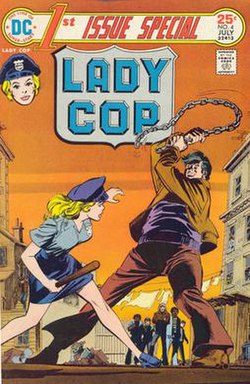Lady Cop
| Lady Cop | |
|---|---|
 Lady Cop from 1st Issue Special #4, artist Dick Giordano.[1] | |
| Publication information | |
| Publisher | DC Comics |
| First appearance | 1st Issue Special #4 (July 1975) |
| Created by | Robert Kanigher John Rosenberger |
| In-story information | |
| Alter ego | Liza Warner |
The Lady Cop is a fictional police officer, a comic book character published by DC Comics. She debuted in 1st Issue Special #4 (July 1975), and was created by Robert Kanigher and John Rosenberger.
The Lady Cop is Liza Warner, a young woman who watches from beneath a bed as a murderer in cowboy boots slaughters her two roommates, leaving the ace of spades behind as his calling card. Later a policewoman (circa 1975) praises her eidetic memory, calling her a "born police officer". Liza enrolls in the unnamed metropolitan city's police academy, performing her civic duty while hoping to one day find the mysterious "killer in boots".[2][3] After a long absence, Liza Warner appeared in The All-New Atom #6 and #12, now as chief of police for Ivy Town.
An antagonistic version of Liza Warner appeared in the fourth and fifth seasons of Arrow, played by Rutina Wesley set in the Arrowverse.
In other media[]
- Rutina Wesley portrays Liza Warner in the fourth and fifth seasons of Arrow. In this depiction, Liza Warner is a police sergeant of the SCPD and a member of the anti-vigilante task force whose unit goes rogue after Quentin Lance disbands the task force following the events of the third season. They clash with Team Arrow and kidnap Lance, but he manages to convince them to surrender, stating that there are other ways to save the city besides rogue justice. Warner later escapes from prison and teams up with Carrie Cutter and China White in an attempt to overtake Star City with Tobias Church's money. The trio are defeated by Team Arrow and arrested by the SCPD.
See also[]
References[]
- ^ Abramowitz, Jack (April 2014). "1st Issue Special: It Was No Showcase (But It Was Never Meant To Be)". Back Issue!. Raleigh, North Carolina: TwoMorrows Publishing (71): 42–43.
- ^ 1st Issue Special #4 (July 1975)
- ^ "Archived copy". Archived from the original on 2008-09-21. Retrieved 2008-10-21.
{{cite web}}: CS1 maint: archived copy as title (link)
External links[]
- DC Comics martial artists
- DC Comics female characters
- Fictional characters with eidetic memory
- Fictional female detectives
- Fictional forensic scientists
- Fictional American police detectives
- Comics characters introduced in 1975
- Characters created by John Rosenberger
- Characters created by Robert Kanigher